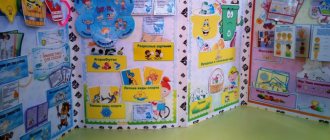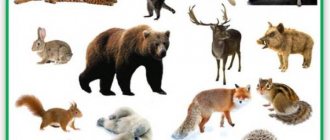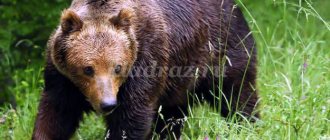Summary of the choreography lesson “Movement is Life”
(integration of educational areas: “Physical Education”, “Health”, “Music”) for middle preschool age
Tasks:
Wellness:
- develop correct posture and leg strength;
- strengthen the arch of the foot;
— develop muscle strength, endurance, speed and strength abilities.
Educational:
— promote the ability of emotional expression, freedom and creativity in movements;
- contribute to the formation of skills, abilities and knowledge of the stylistic features of children's dance performance.
Educational:
- develop coordination, flexibility, imagination, expressiveness in the execution of movements;
- develop a sense of rhythm, ear for music, attention, musical and motor memory.
Educational:
— to cultivate interest in choreography classes through the use of game methods of presenting information;
- develop the ability to work in a team.
Equipment: Music center, audio recordings of the dance teacher show group, musical accompaniment for the dance, dog costume.
Progress of the lesson
- Hello children! My name is Maria Vladislavovna. Today we will try to conduct a choreography lesson together. First we'll warm up a little, then we'll learn a dance and play a little. First, let's learn how to bow, because... We have a dance class, so we should also say hello with a dance movement. Look at me and repeat after me (learning a bow).
- Okay, now put your feet shoulder-width apart, hands on your waist. Repeat after me.
Warm-up
to the soundtrack of the show group “Dance Teacher” (2.45 min)
1 verse
— Tilt your head to your shoulder left and right (8 times), back and forth (4 times);
— We lower our hands down and raise both shoulders up (8), one shoulder at a time (4);
Chorus
- Hands on your waist, feet shoulder-width apart. Lean slightly from side to side (8);
— Feet together, we jump (8);
- Feet shoulder width apart. Hands up and wave from side to side (8);
— Tilts of the head to the shoulder at a slow pace (4);
Verse 2
- “Motors” - rotational movements of hands, clenched into fists, around each other: right - left (2), down - up (2);
Repeat the chorus.
Verse 3
- Turn your legs and body to the right. We perform the “Pinocchio” movement - arms in front of us, one arm straightens, the other bends, fingers widely spread (8). Repeat to the left.
Repeat the chorus.
Verse 4
— We jump: feet shoulder-width apart, arms to the sides - legs together, hands clapping overhead (4 reps at a slow pace, 8 reps at a fast pace).
Repeat the chorus 2 times.
Losing
- Arms to the sides - clap above your head (8).
- And now I will tell you a fairy tale (5 minutes), and you will show it to me. Listen carefully and look at me.
— A beautiful flower grows in a clearing (children, squatting with their hands folded, palm to palm above their heads, depict a flower). Morning comes, the sun rises, and the flower wakes up and opens its petals (the children begin to slowly rise to their feet, stretch their arms up and open them to the sides). A light breeze blew (the children begin to swing their arms from side to side). And now a strong wind has blown, and the flower bends all the way to the ground (the children begin to sway strongly from side to side, trying to reach the floor with their hands). And suddenly the flower broke away and flew away (the children begin to spin around themselves, first in one direction, then in the other). And now the birds have flown to us (children stand on high half-toes and wave their arms up and down). The penguins have arrived (sink on their heels, hands behind their backs). Again birds (half-toes) and penguins (walking on their heels). And now the bees have flown into our clearing! And the bees are buzzing (children begin to run around the hall, pressing their elbows to their bodies, and quickly waving their arms up and down, imitating flying bees). Bees also sit on flowers and collect pollen (children squat down and pretend how bees “collect pollen in a basket”). What do bees give us? (children answer: honey). Okay, which animal loves to eat honey the most? (bear). So a bear came to our clearing! (children place their feet on the outer side of the foot and, reading the verse “Teddy Bear,” imitate it). And now frogs have jumped into our clearing! (children squat down and spread their knees to the sides, placing their hands on the floor between their knees). How do frogs talk? (croak). Who is our biggest frog? (children jump up and clap their hands above their heads). And suddenly cats came to our clearing (the children kneel down and, beautifully moving their hands, walk like cats). They pulled one back leg, then pulled the other back leg. And cats also love to scratch behind the ear with their paw (first with one hand, then with the other), and now who can reach the ear with their back paw?! (children sit on the floor, take their foot and try to touch their toes to their ear). Well done, let's get back on our feet.
- And now I suggest you learn the Dog Dance. But first we will learn the basic movements (No. 2, 5, 6, 7, 8, 9, 10, 12). Look at me and repeat (movement study 2.00 min).
- Children, be quiet, be quiet. I think I hear something. I'll go and have a look. (A child dressed in a Puppy costume enters the hall.) Oh, look who came to us?! It's a dog! Look how funny she is! Let's dance the Dog Dance together with the Puppy.
Dance "Funny Dogs"
Musical accompaniment: Gummy Bear - Gummy Bear song (2.45 min).
1. Children, pressing their bent arms to their chest, with their hands down, run out onto the playground in lines and sit in their seats, on their knees, with their “tails” lowered onto their heels. Place your hands on the floor in front of you.
2. “They say hello” - they wave their heads up and down.
3. With the right “paw”, knock on the floor 8 times, repeat with the left “paw”.
4. Wave their head from side to side 16 times.
5. Scratch the right ear with the right hand 8 times, then scratch the left ear with the left hand.
6. Get on all fours and wag their tails.
7. At “one, two”, raise the “tail” high, straighten the legs, lower the head down; on “three, four” they fall back to their knees, “show your nose” (repeat 4 times).
8. “Spring” - sitting on your knees, bounce slightly on your heels, playing with your “paws” - 16 times.
9. Place your hands on your knees. The legs do not move, and the “tail” sits on the floor, alternately on one side of the legs, then on the other - 8 times.
10. Take the “Butterfly” pose - sit on your buttocks, bend your legs at the knees, press your feet to your feet, press your heels as close to you as possible. Try to touch your knees to the floor, keeping your back straight. Next, take your right foot and touch your right ear with your toe - “scratch” it, then repeat everything from your left foot.
11. Lie on your back and “play with your paws,” that is, wave your legs and arms in the air.
12. Stand on your feet, “paws” - arms pressed to your chest, hands down. On “one, two” jump with your left side towards the audience (to the right), on “three, four” - “wag your tail”, repeat in the other direction (repeat 4 times).
13. They bowed and ran away.
- Fine! Now let's play a little game of "Wet Puppies" (2 min).
Target. The ability to relieve tension alternately from the muscles of the arms, legs, neck, and body; move scattered around the hall.
Progress of the game. Children move around the hall in all directions, like dogs (legs and arms on the floor, knees straight). At the command “rain”, children squat down and curl into a ball, tensing all their muscles. At the command of the “sun”, they slowly stand up and shake off the “raindrops” in turn from each of the four “legs”, from the “head” and “tail”, respectively removing the clamps from all muscles.
— They took their places to bow. Well done! I really liked how you diligently worked and completed everything. What did you like about our lesson? (children's answers) Well done! Thanks for the activity! I really enjoyed working with you. Goodbye (bow)!
“Summary of an open lesson on choreography at an additional education institution”
Author:
Kryuchkov Alexey Vasilievich
teacher of additional education of MAU DO Khabarovsk, "Palace of Children's Creativity "The Little Prince"
Shkrob Svetlana Nikolaevna
methodologist of the MAU DO Khabarovsk, "Palace of Children's Creativity "The Little Prince"
“Summary of an open lesson on choreography at an additional education institution”
Municipal Autonomous Institution of Additional Education of Khabarovsk, “Palace of Children's Creativity “The Little Prince”
Outline of a lesson in a choreographic class in the pop dance ensemble "Inspiration" (mixed male group) of the municipal autonomous institution of additional education in Khabarovsk "Palace of Children's Creativity "The Little Prince" on the topic
" Practicing combinations of a choreographic concert number "
Developed by: Kryuchkov A.V. .,
additional education teacher
Khabarovsk, 2019
Topic of the lesson: “Practicing complex combinations of concert numbers, training stretching elements”
Date of the lesson
: 02/15/2019
Type of lesson:
group creative training session in a children's choreographic association for additional education of children.
Students:
5th year of study, mixed age group of children, age of children from 10 to 14 years.
Lesson duration:
45 minutes
Technologies used in the lesson:
- Health-saving (
creating conditions for the healthy development of students in compliance with organizational and pedagogical rules for conducting classes)
;
- Informational
(active use of audio, musical compositions taken from special music sites on the Internet);
- Technologies of pedagogical communication (
planning a communicative structure, interaction adequate to pedagogical tasks, managing communication, creating an emotional atmosphere);
- Game (
for practicing tempo, using supports, contact improvisation);
- Personality-oriented (
use of elements of multi-level training);
- Peer learning technology;
- Collaboration technology
(in improvisation rehearsal);
- Prospective-advanced training (
the introduction of some complex elements into the warm-up complex helps to reduce the difficulties of performing elements of a concert performance)
Purpose of the lesson:
improving dance technique. Development of emotional expressiveness of a dance performance by repeating the movements learned.
Educational objectives:
1. To consolidate the concept of “mastery of the motor functions of the body”, monitor its coordination, emancipation, and muscle control skills;
- Monitor the degree of assimilation of knowledge, skills and abilities by establishing correct posture during movement and at rest;
- Achieve correct group interaction during the rehearsal session;
- To develop in the group the ability to clearly and synchronously perform dance movements.
Educational tasks
:
- Cultivate persistence and patience when performing certain choreographic elements and movements;
- To form a sense of responsibility, independence and cognitive activity in the group;
- Motivate children to solve assigned problems, awaken curiosity;
- Instill in students a culture of communication and ethical standards of behavior in a group dormitory.
Developmental tasks:
- Develop students' creative activity, thinking, imagination;
- Develop critical thinking and the ability to conduct substantive dialogue in society;
- To develop the aesthetic understanding and artistic taste of students;
- Development of choreographic skills.
Planned educational results:
- Deep assimilation of conscious basic knowledge of mastering dance techniques, the ability to move correctly, beautifully and competently while dancing;
- The ability to communicate with classmates and the teacher, to properly organize joint work to master new dance techniques and compositions;
- Development of self-assessment and reflection skills, the ability to analyze achieved results;
- Balanced development of physiological and mental functions of students, obtaining satisfaction from the lesson;
Basic terms and concepts:
technique and elements of dance, warm-up and cool-down, dance class, solo students, jumping with lunges, “chains of movements”, new elements of dance, support, improvisation,
Equipment,
material and technical base - the presence of a technically equipped office, a tape recorder with connected speakers, the presence of a mirror wall and a machine for controlling movements, easily opening windows, bottled water.
The threefold objective of the lesson:
— Educational:
increase the level of child development
— Educational:
to form the moral qualities of the individual, views and beliefs.
— Developmental:
when teaching, develop students' cognitive interest, creativity, will, emotions, cognitive abilities - speech, memory, attention, imagination, perception.
Lesson plan and structure, approximate timing of each stage
| Stage name | Content | Duration of the stage |
| Organizational moment, greeting, announcement of the topic, and future work plan | 1 minute. |
| Warm-up of the musculoskeletal system, the whole body in combination with proper breathing: head, shoulder girdle, rotation of the body, arms, legs. Jumps forward, backward, a chain of jumps diagonally across the room, with arms raised, side steps, a diagonal cartwheel, running around the perimeter of the choreographic hall | 5 minutes |
| Jumping “squat”, legs parallel, legs to the sides, walking with high legs raised and arms wide apart, “Russian squat” from a squatting position, jumping with straightening the arms and legs and spreading them to the sides with a preliminary demonstration of this exercise by the teacher, training of dance elements “connected chains of movements”. Recommendations from the teacher to the dancers on combining the dance into a single whole, simultaneous coordination, showing some complex movements. Repetition of dance elements to musical orchestration | 12 minutes |
| Work of the teacher with 2 soloists of the ensemble, jumping, synchronization of movements, comments from the teacher, demonstration of the correct execution of movements, dance of the soloists to the music. Practicing and repeating movements by soloists. | 3 minutes |
| Combining a number with solo students and a group dance into a related composition. Dance run without music. Repeating the entire dance number, taking into account the teacher’s comments, to musical accompaniment. Repetition and consolidation of complex elements of movements on counts 1-8. Performing dance movements to music. | 10 minutes |
| Improvisation by the teacher and the introduction of new movements by the teacher into the final element of the dance. Showing movements to the group's soloists, memorizing and practicing the element. Training in performing support, explanations from the teacher on the correct clasping of hands, coordination of joint actions in support. | 10 minutes |
| An element of a squat jump, but with support from the hands behind, stretching the body, high jumps with the connection of arms and legs, stretching the outer surface of the thighs, rolling back with support on the arm laid back, stretching the arms. | 3 minutes |
| Reflection, summing up, sharing impressions, discussing the past lesson. Teacher's assessment of students' work in class, homework, farewell. | 2 minutes |


